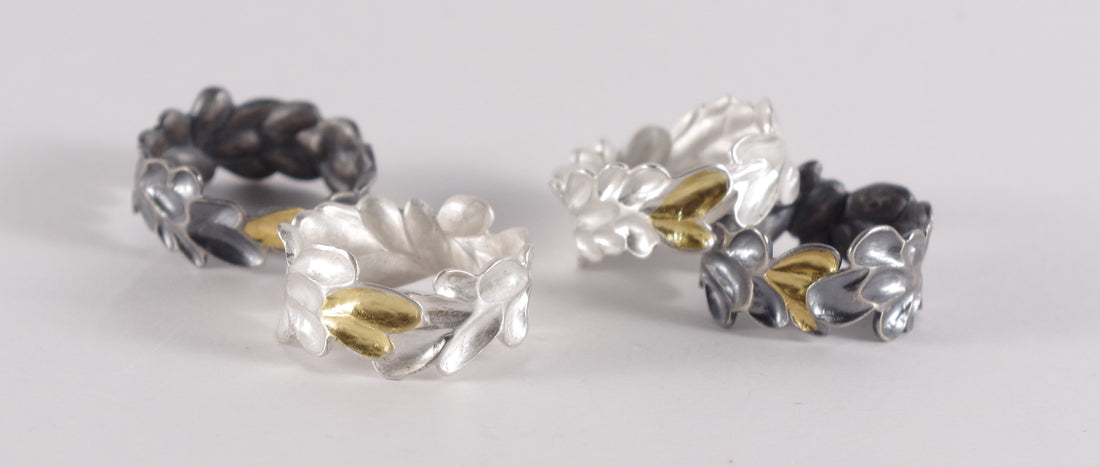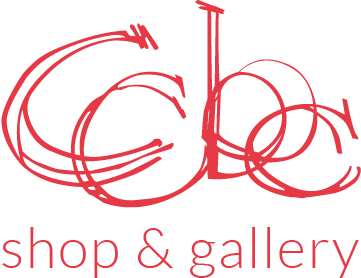
metals: types and properties
Share
Have you ever wondered what “sterling silver” really means, or what “14K gold” stands for? Read on to learn about the types of metal used by our vendors.
This post is an excerpt from pondercraft.ca, CCBC's educational website.
properties
Gold, silver and copper can be found in their pure form in nature. Bronze and brass are alloys (made up of more than one metal and not found in a pure form in nature). Gold is more valuable than silver, which is more valuable than copper. This is due to their relative weights and rarity.
common types
Gold: In its purest form, gold is a bright, slightly reddish yellow, dense, soft and malleable metal. Gold has been a valuable and highly sought-after precious metal for coinage, jewellery and other arts since long before the beginning of recorded history. Because of the softness of pure (24k) gold, it is usually alloyed with base metals for use in jewellery, altering its hardness and ductility, melting point, colour and other properties. Alloys with lower karat rating, typically 22k, 18k, 14k or 10k, contain higher percentages of base metals such as copper, or other precious metals including silver or palladium, in the alloy. Copper is the most commonly used base metal, yielding a redder colour.

Silver: Sterling silver is one of the three precious metals (the others being gold and platinum). It is the most lustrous, most plentiful and least expensive of the precious metals. The standard for sterling silver has remained unchanged since 1300 when Edward I of England established an early trade practice rule for silversmiths, decreeing that sterling must consist of 92.5% pure silver alloyed with 7.5% copper. The copper is added for hardness as fine silver is too soft for use in jewellery. The term "sterling" refers to the composition of the metal, never to the weight of a finished item. Silver is much more plentiful than gold, however, silver tends to tarnish, making it less popular in some forms of jewellery.
Argentium Sterling Silver: Argentium Silver is relatively new and has many advantages over Sterling Silver, such as being brighter, very slow to tarnish and is easy to clean with dish detergent. It is purer than traditional sterling 93.5% versus 92.5% silver and is made of recycled silver, and has a much cleaner, environmentally friendlier process.
Copper: Copper is a soft and malleable metal. The metal and its alloys have been used for thousands of years. Pure copper is orange-red and acquires a reddish tarnish when exposed to air.

Bronze: Bronze is an alloy consisting primarily of copper (around 90%), commonly with about 10% tin. These additions produce a range of alloys that may be harder than copper alone or have other useful properties, such as stiffness, ductility or machinability.
Brass: Brass is a metal alloy made of copper and zinc; the proportions of zinc and copper can be varied to create a range of brasses with varying properties. Brass is often used for decoration for its bright gold-like appearance. It has a relatively low melting point and its characteristics make it a relatively easy metal to cast. Today, almost 90% of all brass alloys are recycled.
Gold Plating: Gold plating is a method of depositing a thin layer of gold onto the surface of another metal, most often copper or silver (to make silver-gilt), by chemical or electrochemical plating.

Vermeil: Vermeil is a gold plating process developed in France in the mid-1700s. A typical example is Sterling Silver coated with 18K or 24K gold. To be considered vermeil, the gold must be at least 10 karats and be at least 2.5 micrometres thick. Vermeil pieces appear to be gold but are much cheaper and lighter than solid gold.

Keum-boo: Keum-boo (also Kum-Boo or Kum-bu — Korean meaning "attached gold") is an ancient Korean gilding technique used to apply thin sheets of gold to silver, to make silver-gilt. Traditionally, this technique is accomplished by first depleting a surface of sterling silver to bring up a thin layer of fine silver. Then 24 karat gold foil is applied with heat and pressure.

Enamel: Vitreous enamel is a form of glass that can be applied to a variety of metal substrates including, copper, fine or sterling silver, gold, and steel. The enamel manufacturer combines the glass with other elements such as silica, flint, soda potash, and borax to form the fusibility. Metal oxides give the enamel its colour. Enamel is available in different types including transparent, opaque, opalescent, painting and liquid and may be leaded or unleaded. Enamelling techniques include cloisonné; champlevé, plique-a-jour, Limoges (painting), basse taille, and can include silkscreening, graffito, stamping, and decals. Enamel can be applied with different methods including sifting or screening dry enamel powder. The enamel powder may be mixed with distilled water and packed into a cloisonné formed out of wire or a cell created by etching. Liquid enamel can be sprayed, brushed or dipped and poured. Painting enamel is applied by brush. The enamels are fired in a kiln or with a torch to a high temperature ranging between 1400-1700 F. The enamel melts, flows and then hardens to a smooth, durable, vitreous coating on the metal. Enamelling is an old technology and has been used for thousands of years, often in jewellery making.
Learn more about clay and other craft mediums at ponder craft and design, CCBC's educational website.
cover image: Bloom Rings - Erin Christensen
in-text: Heavy loop Necklace - Madeleine Chisholm, Earth + Sky Earrings - ZULA, Honeycomb with Bee Ring - Even Design, Composition Brooch - Erin Christensen, Potsu potsu earrings II - Suzanne Squires
